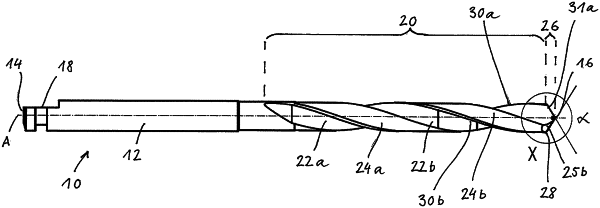| CPC A61C 3/02 (2013.01) [B23B 51/02 (2013.01); A61C 2201/00 (2013.01)] | 21 Claims |

|
1. A dental drill configured for forming a hole in an oral cavity, formed of titanium or a titanium alloy having a hardness greater than pure titanium, said drill extending along a central axis from a proximal end to a distal end, the drill comprising
a shank arranged in a proximal end region of the drill and extending along the central axis,
a flute portion arranged distally to and running coaxially with the shank said flute portion comprising two or more flutes extending along the flute portion and being interposed by lands, the flute portion further comprising a central solid web and
a drill point directly adjoining the distal end of the flute portion and comprising two or more flanks which taper radially inwardly from the distal end of each land in the distal direction toward the central axis, each flank comprising a cutting edge,
wherein at the distal end of the drill point at least one groove is formed in the web such that the distal most end of at least one of the flanks is located radially remote from the central axis.
|